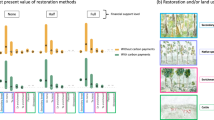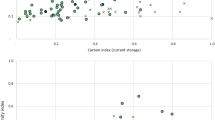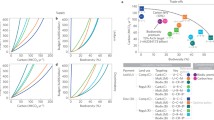Abstract
Afforestation and reforestation (A/R) projects generate greenhouse gas (GHG) reduction credits by removing carbon dioxide from the atmosphere through biophysical processes and storing it in terrestrial carbon stocks. One feature of A/R activities is the possibility of non-permanence, in which stored carbon is lost though natural or anthropogenic disturbances. The risk of non-permanence is currently addressed in Clean Development Mechanism (CDM) A/R projects through temporary carbon credits. To evaluate other approaches to address reversals and their implications for policy and investment decisions, we assess the performance of multiple policy and accounting mechanisms using a forest ecosystem simulation model parameterized with observational data on natural disturbances (e.g., fire and wind). Our analysis finds that location, project scale, and system dynamics all affect the performance of different risk mechanisms. We also find that there is power in risk diversification. Risk management mechanisms likewise exhibit a range of features and tradeoffs among risk conservatism, economic returns, and other factors. Rather than relying on a single approach, a menu-based system could be developed to provide entities the flexibility to choose among approaches, but care must be taken to avoid issues of adverse selection.





Similar content being viewed by others
Notes
http://www.ncdc.noaa.gov/stormevents/ftp.jsp Cited 6 August 6 2012.
http://www.spc.noaa.gov/faq/tornado/f-scale.html Cited 6 August 2012.
Thresholds are based on categories and descriptions of loss detailed on pp 350–1 in Mason (2002), though the assignment of loss percentages to each threshold is ours alone. Assessing the risk of wind damage is a complicated undertaking, and we acknowledge this treatment vastly oversimplifies the effect of wind disturbance on forest stands. See, e.g., Quine (1995), Moore and Quine (2000), and Mason (2002) for more information.
See the following CDM project descriptions: http://cdm.unfccc.int/Projects/DB/JACO1260322827.04/view and http://cdm.unfccc.int/Projects/DB/JACO1245724331.7/view Cited 15 February 2012.
References
Bermejo I, Cañellas I, San Miguel A (2004) Growth and yield models for teak plantations in Costa Rica. For Ecol Manag 189:97–110
Bird DN, Dutschke M, Pedroni L et al. (2004) Should one trade tCERs or ICERs? ENCOFOR
Blanco G, Gerlagh R, Suh S et al. (2014) Drivers, Trends and Mitigation. In: Climate Change 2014: Mitigation of Climate Change. IPCC Working Group III contribution to the 5th Assessment Report of IPCC. http://www.mitigation2014.org. Cited 12 May 2014
Brown S, Burnham M, Delaney M et al (2000) Issues and challenges for forest-based carbon-offset projects: a case study of the Noel Kempff climate action project in Bolivia. Mitig Adapt Strateg Glob Chang 5:99–121
Clean development mechanism (CDM) (2012). Project cycle search. http://cdm.unfccc.int/Projects/projsearch.html Cited 6 August 2012
Cooley DM, Cousky K, Galik CS, Holmes T, Cooke R (2012) Managing dependencies: towards a more complete evaluation of forest offset reversal risk. Mitig Adapt Strateg Glob Chang 17:17–24
Dale VH, Joyce LA, McNulty S et al (2001) Climate change and forest disturbances. Bioscience 51:723–734
Diaz D, Hamilton K, Johnson E (2011) State of the forest carbon markets 2011. Ecosystem Marketplace, Washington
Galik CS, Cooley DM (2012) What makes carbon work? A sensitivity analysis of factors affecting forest offset viability. For Sci 58:540–548
Galik CS, Jackson RB (2009) Risks to forest carbon offset projects in a changing climate. For Ecol Manag 257:2209–2216
Harmon ME (2012) The forest sector carbon calculator. http://landcarb.forestry.oregonstate.edu/default.aspx Cited 2 September 2012
Kaul M, Mohren GMJ, Dadhwal VK (2010) Carbon storage and sequestration potential of selected tree species in india. Mitig Adapt Strateg Glob Chang 15:489–510
Kim M, McCarl BA, Murray BC (2008) Permanence discounting for land-based carbon sequestration. Ecol Econ 64:763–769
Maréchal K, Hecq W (2006) Temporary credits: a solution to the potential non-permanence of carbon sequestration in forests? Ecol Econ 58:699–716
Mason WL (2002) Are irregular stands more windfirm? Forestry 75:347–355
Moore J, Quine CP (2000) A comparison of the relative risk of wind damage to planted forests in border forest park, Great Britain, and the Central North Island, New Zealand. For Ecol Manag 135:345–353
Moura-Costa P, Wilson C (2000) An equivalence factor between CO2 avoided emissions and sequestration—description and applications in forestry. Mitig Adapt Strateg Glob Chang 5:51–60
Murray BC, Sohngen BL, Ross MT (2007) Economic consequences of consideration of permanence, leakage and additionality for soil carbon sequestration projects. Clim Chang 80:127–143
Noble I, Apps M, Houghton R et al (2000) Implications of different definitions and generic issues. In: Watson RT, Noble IR, Bolin B et al (eds) Special report on land use, land-use change, and forestry. Intergovernmental panel on climate change. Cambridge University Press, Geneva
Olschewski R, Benítez PC (2005) Secondary forests as temporary carbon sinks? The economic impact of accounting methods on reforestation projects in the tropics. Ecol Econ 55:380–394
Paul T, Kimberley M, Beets P (2008) Indicative forest sequestration tables. Prepared for the New Zealand ministry of agriculture and forestry, by Scion. Rotura, NZ
Quine CP (1995) Assessing the risk of wind damage to forests: practice and pitfalls. In: Coutts MP, Grace J (eds) Wind and trees. Cambridge University Press, Cambridge
Smith JE, Heath LS, Skog KE et al. (2006) Methods for calculating forest ecosystem and harvested carbon with standard estimates for forest types of the United States. Gen. Tech. Rep. NE-343. U.S. department of agriculture, forest service, Northeastern Research Station, Newtown Square, PA
Sohngen B (2003) An optimal control model of forest carbon sequestration. Am J Agric Econ 85:448–457
Subak S (2003) Replacing carbon lost from forests: an assessment of insurance, reserves, and expiring credits. Clim Pol 3:107–122
United nations environment programme (UNEP) (2012) CDM/JI Pipeline as of Jan 1, 2012. United nations environment programme (UNEP) RISO Center. http://cdmpipeline.org/cdm-projects-type.htm Cited 14 February 2012
UNFCCC (2011a) Decision 2/CMP.7 Land use, land-use change, and forestry. December, 2011
UNFCCC (2011b) Decision 10/CMP.7. Modalities and procedures for carbon dioxide capture and storage in geological formations as clean development mechanism project activities. FCCC/KP/CMP/2011/10/Add.2. http://unfccc.int/files/meetings/durban_nov_2011/decisions/application/pdf/cmp7_carbon_storage_.pdf Cited 14 February 2014
Environmental Protection Agency (2009) EPA analysis of the American clean energy and security act of 2009 in the 111th congress. Office of Atmospheric Programs, Washington
Van Wagner CE (1978) Age-class distribution and forest fire cycle. Can J For Res 8:220–227
Verified Carbon Standard (VCS) (2012) AFOLU non-permanence risk tool. VCS version 3 procedural document. 4 October 2012, v3.2. http://v-c-s.org/sites/v-c-s.org/files/AFOLU%20Non-Permanence%20Risk%20Tool%2C%20v3.2.pdf Cited 12 April 2013
Acknowledgments
The authors gratefully acknowledge the financial support and content guidance from the World Bank BioCarbon Fund team, especially Rama Chandra Reddy, Marco van der Linden, Ken Andrasko, Klaus Oppermann, and Ellysar Baroudy. The research benefited greatly from input provided at two workshops held at the World Bank in November 2011 and April 2012, as well as review comments on an earlier draft of this report by Derik Broekhoff, Peter Graham, John Kadyszewski, and Ruben Lubowski. We thank Gordon Smith, Tibor Vegh, and David Gordon for data and research assistance. All errors and omissions remain those of the author team and not the sponsors or reviewers of this work.
Author information
Authors and Affiliations
Corresponding author
Rights and permissions
About this article
Cite this article
Galik, C.S., Murray, B.C., Mitchell, S. et al. Alternative approaches for addressing non-permanence in carbon projects: an application to afforestation and reforestation under the Clean Development Mechanism. Mitig Adapt Strateg Glob Change 21, 101–118 (2016). https://doi.org/10.1007/s11027-014-9573-4
Received:
Accepted:
Published:
Issue Date:
DOI: https://doi.org/10.1007/s11027-014-9573-4




